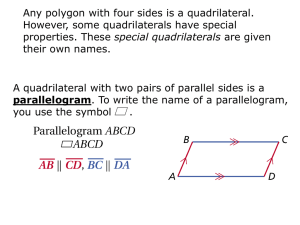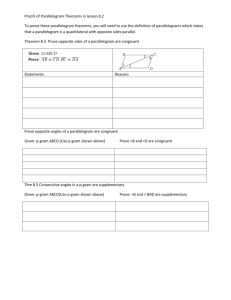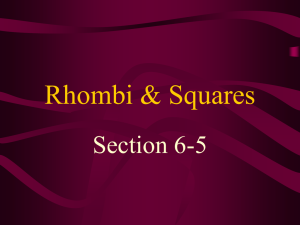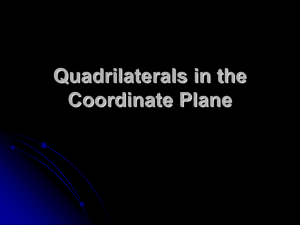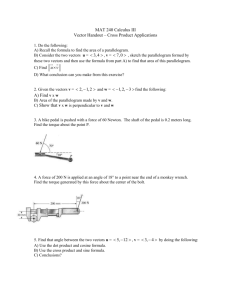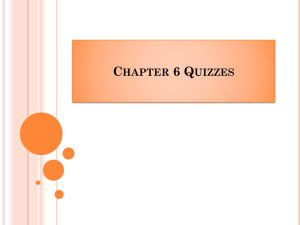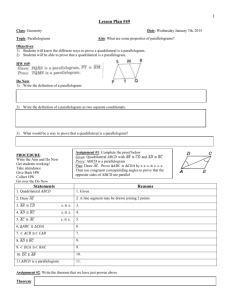Problem Solving with Reflections
advertisement
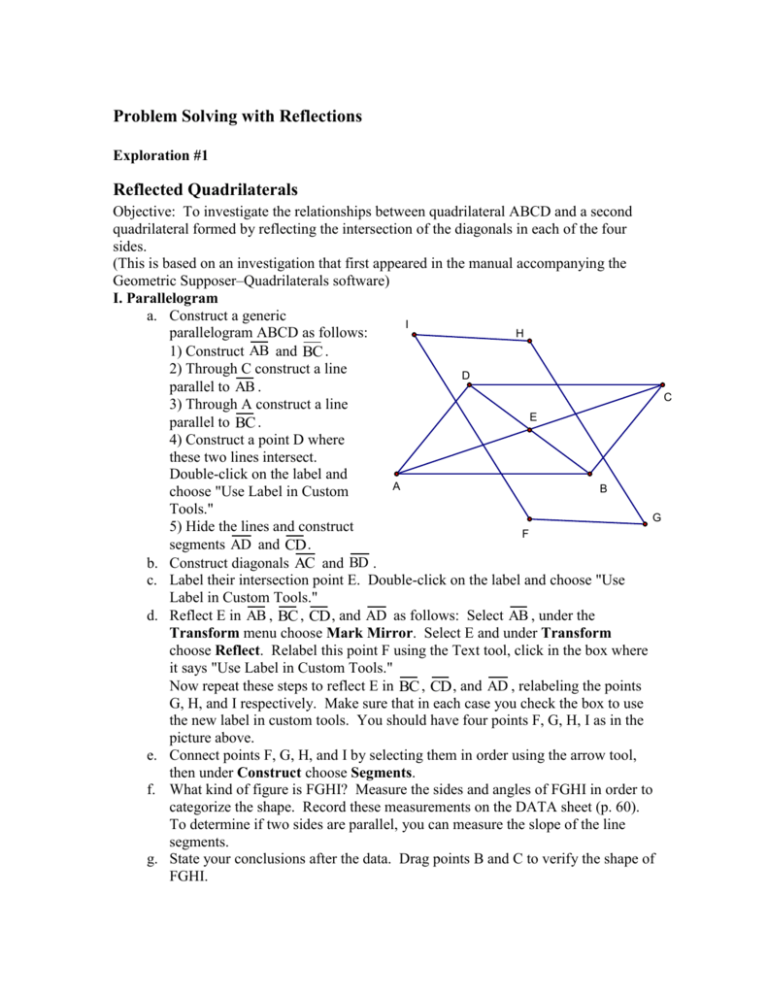
Problem Solving with Reflections Exploration #1 Reflected Quadrilaterals Objective: To investigate the relationships between quadrilateral ABCD and a second quadrilateral formed by reflecting the intersection of the diagonals in each of the four sides. (This is based on an investigation that first appeared in the manual accompanying the Geometric Supposer–Quadrilaterals software) I. Parallelogram a. Construct a generic I H parallelogram ABCD as follows: 1) Construct AB and BC . 2) Through C construct a line D parallel to AB . C 3) Through A construct a line E parallel to BC . 4) Construct a point D where these two lines intersect. Double-click on the label and A B choose "Use Label in Custom Tools." G 5) Hide the lines and construct F segments AD and CD . b. Construct diagonals AC and BD . c. Label their intersection point E. Double-click on the label and choose "Use Label in Custom Tools." d. Reflect E in AB , BC , CD , and AD as follows: Select AB , under the Transform menu choose Mark Mirror. Select E and under Transform choose Reflect. Relabel this point F using the Text tool, click in the box where it says "Use Label in Custom Tools." Now repeat these steps to reflect E in BC , CD , and AD , relabeling the points G, H, and I respectively. Make sure that in each case you check the box to use the new label in custom tools. You should have four points F, G, H, I as in the picture above. e. Connect points F, G, H, and I by selecting them in order using the arrow tool, then under Construct choose Segments. f. What kind of figure is FGHI? Measure the sides and angles of FGHI in order to categorize the shape. Record these measurements on the DATA sheet (p. 60). To determine if two sides are parallel, you can measure the slope of the line segments. g. State your conclusions after the data. Drag points B and C to verify the shape of FGHI. We want to repeat this experiment with other parallelograms, such as rhombus, rectangle, and square. To make this easier, we want to create a custom tool. Select everything. While all of these are selected, click on the custom tool button in the toolbox. (Looks like a triangle with three dots. Choose Create New Tool. Then give your tool a name, such as refl.parallelograms. You can save this tool by going to file, Save As, locating the Tool Folder in the Sketchpad folder, and naming the sketch (refl-para.gsp). This tool will be available as long as the sketch is open. If you close the sketch without saving, the tool disappears. II. Rhombus: Get a new sketch. Construct segment AB. Now select point B and segment AB. Under the Construct menu choose Circle by Center+Radius. While the circle is selected, under Construct choose Point on Circle. Now hide the circle and label the point C. Click on the toolbox, scroll down to "Other Documents" where you should see the document where you created the tool. (May be called "Untitled 4" or something like that.) You should see your tool listed to the right. Select that tool, then go to your rhombus, point at A and click, then point at B and click, then point at C and click. Parallelogram ABCD will be a rhombus. At this point you should have quadrilateral FGHI constructed. What is FGHI? Is it also a special parallelogram? Identify what kind of parallelogram it is. Record your measurements and conjectures on the DATA sheet (p. 60). III. Rectangle: Get a new sketch. Construct segment AB. Through point B construct a perpendicular to AB . Construct a point C on this line. Hide the perpendicular and construct segment BC Click on the toolbox, and select the tool for reflected parallelograms, then go to your three points and click on A, B, and C in that order. Parallelogram ABCD will be a rectangle. At this point you should have quadrilateral FGHI constructed. Drag C so you don't have a square. What is FGHI? Is it also a special parallelogram? Identify what kind of parallelogram it is. Record your measurements and conjectures on the DATA sheet (p. 60). IV. Square: Get a new sketch. Construct segment AB. Now select point B and under the Transform menu Mark Center. Select point A and under the Transform menu choose Rotate. Type in –90˚. Label the point C. Click on the toolbox, and select the tool for reflected parallelograms, then go to your three points and click on A, B, and C in that order. Parallelogram ABCD will be a square. At this point you should have quadrilateral FGHI constructed. What is FGHI? Is it also a special parallelogram? Identify what kind of parallelogram it is. Record your measurements and conjectures on the DATA sheet (p. 60). V. Kite: A kite is not a parallelogram, so we cannot use our script for this one. Get a new sketch. Construct a segment. Construct a Midpoint. Construct a Perpendicular to the segment through the midpoint. Construct two B points on this perpendicular on opposite sides of the original segment. Connect the four endpoints, and relabel as necessary, to form a kite ABCD. Hide the perpendicular line and construct the diagonal, labeling A the intersection E. You should have AB = BC, AD = E C CD, and AE = CE. (See figure at left.) D Now reflect E in each of the four sides and relabel the resulting points F, G, H, and I. Measure as before. Drag the vertices of the kite to verify your conjectures. Record your measurements and conjectures on the DATA sheet (p. 60). VI. Isosceles Trapezoid: Get a new sketch. Construct segment AB and segment BC. Through C construct a line parallel to AB . Select A and BC and construct a circle with center A and radius = BC in order to have AD = BC. Label the point D where the circle and parallel line intersect such that AD is not parallel to BC . Hide the circle and the parallel line. Construct segments CD and AD. Construct the diagonals and label the point of intersection E. (See sketch below.) Now reflect E in each of the four sides and relabel the resulting points F, G, H, and I. Measure as before. Drag point C to verify your conjectures. You should notice that there are two possibilities for figures — convex and concave quadrilaterals are possible. Record your measurements and conjectures on the DATA sheet (p. 60). D C E A B DATA SHEET Shape of FG ABCD Parallelogram GH HI IF FGH GHI HIF IFG Rhombus Rectangle Square Kite Isosceles trapezoid Isosceles trapezoid Conclusions a. If ABCD is a parallelogram, then FGHI is a b. If ABCD is a rhombus, then FGHI is a c. If ABCD is a rectangle, then FGHI is a d. If ABCD is a square, then FGHI is a e. If ABCD is a kite, then FGHI is a f. If ABCD is an isosceles trapezoid, then FGHI is a . or Shape of FGHI
